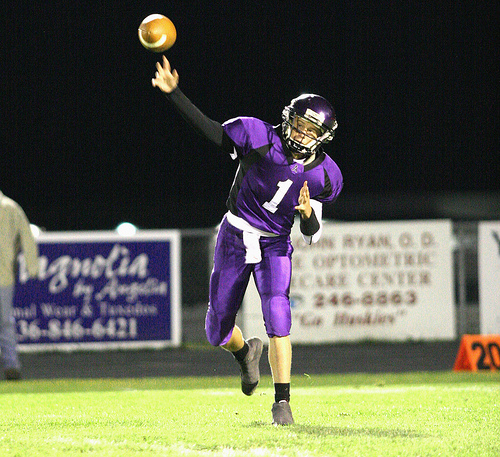
 There's an author making the case against high school sports, new research that shows a skyrocketing number of children being diagnosed with myopia and a major organization calling on parents to clamp down on kids' media intake. For this month’s education roundup, CPR education reporter Jenny Brundin talks with Colorado Matters host Ryan Warner about several provocative stories she’s been reading.
There's an author making the case against high school sports, new research that shows a skyrocketing number of children being diagnosed with myopia and a major organization calling on parents to clamp down on kids' media intake. For this month’s education roundup, CPR education reporter Jenny Brundin talks with Colorado Matters host Ryan Warner about several provocative stories she’s been reading.
The following is a transcript of their conversation.
Ryan Warner: We’ll start with an article you read in The Atlantic. It’s called The Case Against High School Sports. Wow, Jenny, are you really ready to take that on?
Jenny Brundin: No way! This is just a really interesting read that kind of forces you to think a little more deeply about something that has seemed sacred for decades -- high school sports.
Ryan Warner: So what’s the major thesis of the article?
Jenny Brundin: Well Ryan, what’s the first thing you see usually, when you walk into a high school?
Ryan Warner: The trophy case.
Jenny Brundin: Exactly. So this really sends a message about what the school values. The author Amanda Ripley asks the question: “What if Americans transferred our obsessive intensity about high school sports—the rankings, the trophies, the ceremonies, the pride—to high school academics?”
Ryan Warner: So the idea might be I walk into a high school and instead, I see the awards I got for being in Model United Nations. How much money goes into high school sports, compared to other areas?
Jenny Brundin: She reports that the U.S. routinely spends more tax dollars per high-school athlete than per high-school math student—unlike most countries worldwide. She starts the article by interviewing exchange students who are truly amazed by the emphasis on sports in American high schools.
Ryan Warner: How did public schools come to be so involved in sports?
Jenny Brundin: This is fascinating. It started in private schools. The author writes that the “ruling elite feared schooling would make Anglo-Saxon boys soft and weak, compared to their brawny, newly immigrated peers. Oliver Wendell Holmes Sr. warned that cities were being overrun with ‘stiff-jointed, soft-muscled, paste-complexioned youth.’”
Ryan Warner: So the author focuses on one Texas district that was struggling both financially and academically.
Jenny Brundin: Yes. Here’s the situation: The district had already laid off employees and closed the middle school campus. The elementary school hadn’t had an art or a music teacher in years, and the high school had sealed off the science labs, which were infested with mold. Yet the high school still turned out football, basketball, volleyball, track, tennis, cheerleading, and baseball teams each year.
Ryan Warner: And the author goes into detail about all the costs associated with those sports, particularly with high school football teams. The state meanwhile, was threatening to shut down the district.
Jenny Brundin: Yes. So the superintendent did something truly radical for Texas. He shut down all sports programs-including football.
Ryan Warner: What happened?
Jenny Brundin: People were upset initially. Student athletes didn’t understand. But in that first semester, 80 percent of the students passed their classes, compared with 50 percent the previous fall. About 160 people attended parent-teacher night, compared with 6 the year before. The district implemented other changes at the same time, including more teacher training, mandating that students wear uniforms, and other reforms. But the superintendent believes suspending sports was crucial because it changed the school culture.
Ryan Warner: Changing school culture. What does that mean?
Jenny Brundin: People said the school was focused on academics now and was calm. There were virtually no more fights. Even former athletes said there was all this extra time to focus on school work.Communities throughout Texas were alarmed by the cancellation of football, and they raised $400,000 for the high school - money that the superintendent put toward renovating the moldy science labs.
Ryan Warner: Don’t high-school sports offer exercise, lessons in sportsmanship and perseverance, school spirit, and just plain fun?
Jenny Brundin: Yes. And the author acknowledges all of those. If you’ve seen the absolutely fabulous Oscar-winning documentary “Undefeated” about an underdog football team in a very poor area of Memphis – you’ll know how much an incredible coach can be an invaluable mentor. But as Amanda Ripley traveled the world studying different school systems, she began wondering about the trade-offs here. Researchers say other countries have found ways to motivate kids and improve academic performance and we need to focus more on engaging kids in the classroom, keeping kids in school for the right reasons.
Ryan Warner: Of course this raises the whole question of college sports. If you don’t have high school sports, what about the next step?
Jenny Brundin: Yes. That’s where sports are dominant. But the author gives the example of Spelman College, an all-black women’s college in which half of the incoming class was obese or had high blood pressure or Type 2 diabetes. The president looked at the $1 million being spent on elite athletics that served just 4 percent of the campus population. She dropped athletics and instead put the money into a campus wide health and fitness program to teach lifelong healthy habits.
Ryan Warner: You read another interesting article in Slate magazine. It’s about the explosion in the number of children suffering from myopia or nearsightedness.
Jenny Brundin: Yes, in some parts of Asia it has reached nearly epidemic proportions. In Taiwan, the percentage of 7-year olds suffering from near-sightedness went from about 5 percent in 1983 to 21 percent in 2000. Eighty-one percent of 15 year olds there are myopic.
Ryan Warner: And we should say that extreme forms of the disorder are risk factors for retinal detachment, glaucoma and blindness. What’s causing the spike?
Jenny Brundin: Researchers believe they are now closing in on a primary culprit: too much time indoors. They studied two groups of kids - one group in Singapore and the other - kids of Chinese descent in Australia. The usual suspects for causing myopia– too much reading, and too much time in front of an electronic screen – couldn’t account for the huge increase in the incidence of myopia. But difference in time spent outdoors was huge. 13 hours a week in Australia versus 3 hours in Singapore.
Ryan Warner: So spending too much time indoors harms children’s vision?
Jenny Brundin: A systematic review of previous studies concludes that each hour spent outside per week reduces a child’s chance of developing myopia by 2 percent. Outdoor light is usually about 100 times more intense than light inside.
Ryan Warner: So why might the outdoors protect children from nearsightedness?
Jenny Brundin: Well, there isn’t broad agreement. One hypothesis is that kids focus their gaze on more distant objects in the outdoors. When they’re inside, they’re usually looking at a computer screen, or a book, or something really close up.
Ryan Warner: What about myopia levels in American children?
Jenny Brundin: A study a few years ago showed children here spend about half as much time outdoors as they did in 1980. Myopia here hasn’t reached the levels being seen in Asia but it’s rising quickly.
Ryan Warner: Related to this is information about how much time children should be using their computers and their phones. You have something from the American Academy of Pediatrics. What is their recommendation?
Jenny Brundin: Their message to parents is – for Pete’s sake – limit your kids’ texts, tweets and online activity to two hours a day. Online homework is an exception.
Ryan Warner: How much are kids using entertainment media now?
Jenny Brundin: A staggering amount. On average, more than seven hours daily. That is more time than they spend in classrooms.
Ryan Warner: And why the new policy?
Jenny Brundin: It is not the cause of course, but researchers say kids’ online activity [has] been linked with violence, cyberbullying, academic problems, obesity, lack of sleep and a host of other problems. The lead author of the new policy says many parents are “clueless” about the profound impact media exposure can have on their children.
Ryan Warner: Well this may also be a culture change for parents as well who also spend a lot of time online and speaking of adults, there is this test American adults took. It’s not dissimilar from something we’ve heard in the news recently called PISA, which is actually a test of American school-kids worldwide. That test shows kids here aren’t doing as well as many of their international peers. But what does this adult test say about their place in the world.
Jenny Brundin: Unfortunately it showed they also score poorly on a global test.
Ryan Warner: This was a test of 166,000 adults in more than 20 industrialized countries?
Jenny Brundin: Yes. In math, reading and problem-solving using technology, American adults scored below the international average. Adults in Japan, Canada, Australia, Finland and many other countries scored significantly higher than the U.S. in all three areas of the test. To give you an idea, the average scores in literacy range from 250 in Italy to 296 in Japan. The U.S. average score was 270.
Ryan Warner: And the study found that it made a difference if test-takers had college-educated parents?
Jenny Brundin: Yes, there was a huge gulf in scores between American test-takers with college educated parents and those without.









